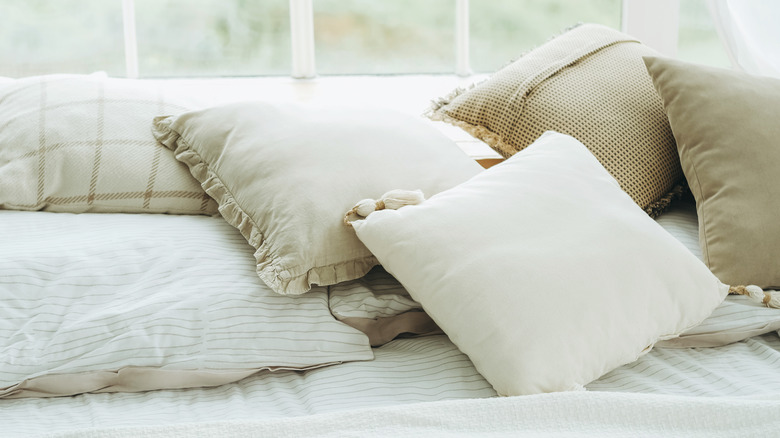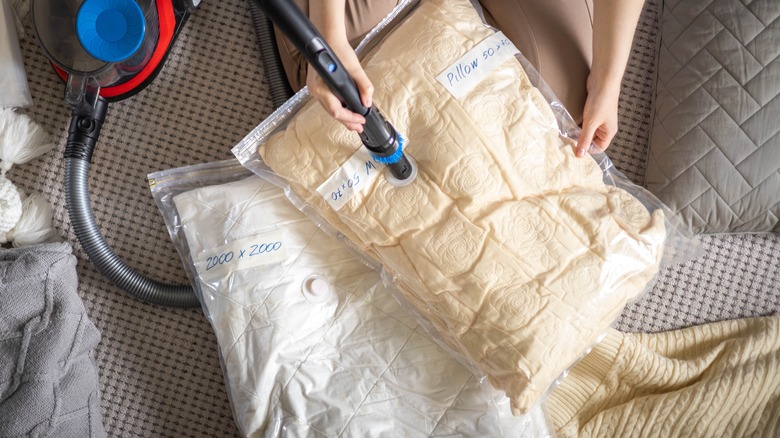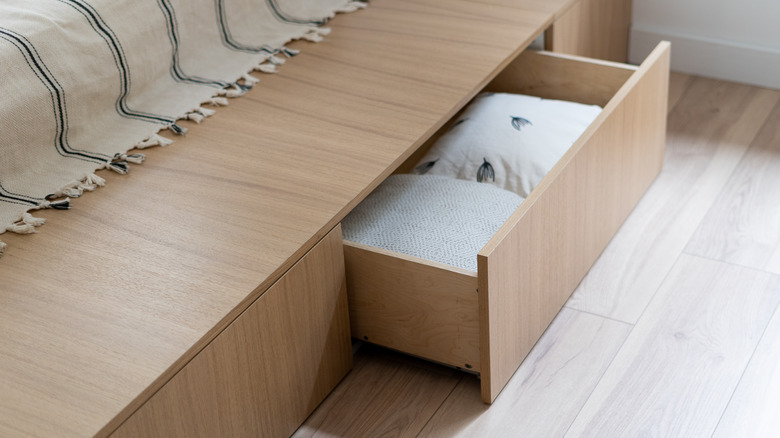There's One Massive Downside To This Common Pillow Storage Solution
While every homeowner has different preferences, there is such a thing as having too many throw pillows. If you've spent some time rearranging your living room or bedroom, you may find that you have some extra pillows around that you don't know what to do with. While people commonly use plastic bags to store pillows, it's not as good of a solution as it first appears. Storing pillows in sealed plastic bags comes with some problems — the bag can collect and trap moisture and potentially damage the pillow.
Condensation is the number one problem you'll want to look out for when storing pillows in a plastic bag. If not airtight, plastic bag storage can lead to mold and mildew growth. This is most likely to happen if temperatures fluctuate in the room where they're stored. If you're storing pillows in a standard plastic bag or a plastic trash bag, poking some holes in the bags can help prevent this and allow for adequate airflow. However, you may want to rethink the use of standard plastic bags altogether and consider other options to ensure they'll stay protected while put away. Always think carefully about your approach when storing pillows and other types of bedding if you want them to stay in great condition.
Preventing wrinkles when using vacuum storage bags
If you can't store pillows in just any sealed plastic bag, your next thought may be to use vacuum bags. It's true that vacuum storage bags can be a worthy storage option and can save a lot of space. However, they're not perfect. Despite preventing moisture and mold, using vacuum bags can cause pillows and other linens to become wrinkled and lose their shape, especially if stored for a long time.
Many bedding items, including comforters, sleeping bags, and pillows, need air in them to stay fluffy and soft. A vacuum bag may compress these items too much, sucking the air out of the materials and flattening them. While synthetic comforters will usually stay in fairly good shape, down comforters and pillows, in particular, won't fare well. Shaking out and plumping pillows and down comforters, washing them thoroughly, steaming them, and airing them out usually help, but in some cases, restoration is difficult. While there are some genius ways to repurpose an old comforter, it's best to keep it in great shape as long as possible. Vacuum bags can potentially cause another problem as well. When stored long-term, the plastic smell can leak into the fabric.
Despite these drawbacks, vacuum storage can still be a great option for storing pillows. To prevent problems, however, it's important not to store them too long. Air out these bags every six months or so to keep your items looking great. Don't leave pillows in them for more than six months without opening them up and letting them air out. Once you've done this, you can close the bags again and continue storing them.
Other tips for storing your pillows correctly
Aside from using standard plastic bags and vacuum bags, there are a few other ways to store pillows. There are also some things to remember to give them the best chance of remaining moisture-free and retaining their shape. As an alternative to vacuum bags, consider storing pillows, comforters, and other cloth items in cotton storage bags. These can do a better job of preventing moisture while also preventing the collection of dust and keeping bugs away. For extra protection from moisture and damage when storing pillows, you may want to place them in clean pillowcases. This is ideal for throw pillows as well. Another simple storage alternative is to place linens on a shelf and cover them with an old sheet.
In addition to these storage solutions, you can provide your pillows with extra protection by placing them inside a plastic tub after you've put them in a cotton storage bag or pillowcase. Then, place the tub in a room that has a steady temperature. You may want to make use of a small linen closet or place them in another cool, dark place. Be sure to label the plastic tub clearly so that you can easily identify what's inside later on.


